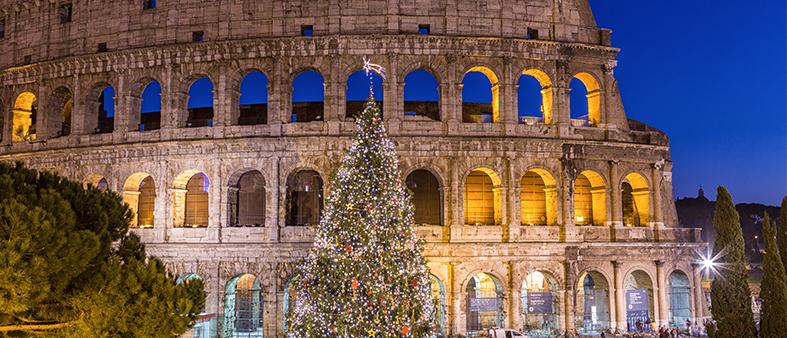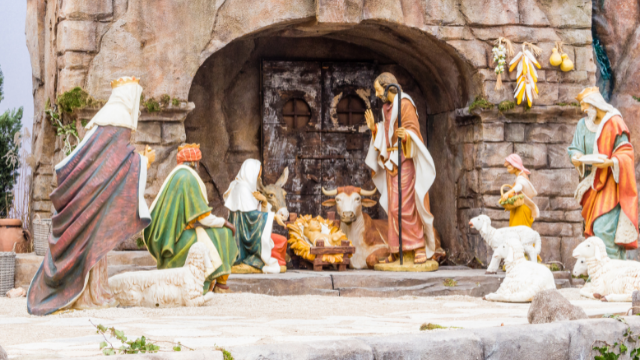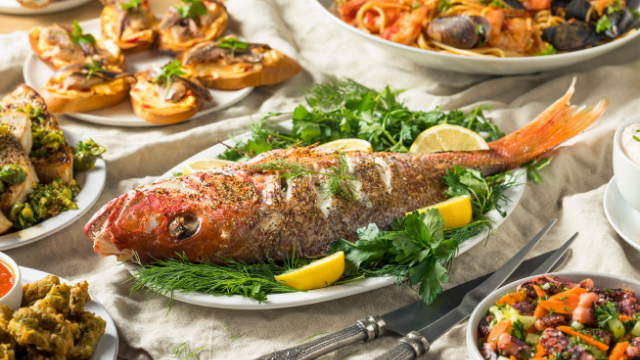
Christmas in Italy is a big, big deal.
Christmas holidays are approaching. From the south to the north, and passing through the center, people across “lo Stivale” (the Boot) are getting ready to celebrate Christmas (il Natale) with their loved ones.
Read on to learn about the most important Italian Christmas Traditions (tradizioni natalizie), popular holiday foods, and the characters that make this season such a magical and enchanting one. New Year’s in Italy arrives in the middle of the holiday season, and has its own special set of food and traditions.
An Italian’s (Very Busy) Christmas Calendar
Le Feste Natalizie (Christmas holidays or celebrations) are a huge deal in Italy. We don’t have only a day or two dedicated to celebrations, but an entire month!
Therefore, it is more accurate to talk about “Il Periodo Natalizio” (Christmas Period or Season) which runs from early in December all the way through L’Epifania (Epiphany) on January 6.
Since in Italy Christmas is still very much tied to religion, many dates associated with it happen during Avvento (Advent).
For those of you who observe Christian traditions, you probably know what this means. For those who don’t, Avvento is Advent, or the approximately 4-week period preceding Christmas day, when Christians prepare for the birth of Christ.
Although the dates preceding Christmas day (Il giorno di Natale) bring a particular excitement and eagerness to them, there are more after that.
As the long and complicated history of Italy is one made of regional differences and contrasts, uses and customs tend to vary from city to city (da città a città) and among regions (tra regioni). However, there are a few unforgettable Christmas dates that every Italian knows by heart. Let’s take a look at the most important ones.
Immacolata Concezione (8th of December), or the Immaculate Conception:
This is the day in which, according to scriptures, Mary conceived Jesus through the Holy Spirit (lo Spirito Santo) and it is the official beginning of the holiday season for most Italians.
It also signs the day in which Italians set up and decorate their Christmas tree (Albero di Natale) and the nativity scene (il Presepe).
The latter is especially important in Italy––and particularly in the South––where in cities like Napoli, during Christmas entire streets are occupied by giant nativity scenes, sometimes with moving figures and live actors.

Some of the most important figures in the nativity scene (Presepe) that you need to be able to recognize are:
- Il bue e l’asinello (the ox and the donkey), usually placed behind baby Jesus, as the story says that their breath warmed him
- Maria e Giuseppe (Mary and Joseph), usually placed next to the cradle
- Gesù Bambino (Baby Jesus), who usually is placed in the cradle on the 25th of December
- I Re Magi (the three kings), who, according to the scriptures, followed the comet (la stella cometa) to reach the nativity scene with precious gifts for Jesus.
La Novena (16th-24th of December), or the nine days before Christmas: Italian Christmas Markets
It is around these dates, yet usually starting around the 8th of December, that Italian towns and cities start to brim with Christmas Markets (Mercatini di Natale).
Around this time, you’ll be able to find Christmas-themed gifts and foods for your family and friends.
However, you might also spot the Zampognari (bagpipe players), who are usually also found as figures in the Presepe.
They usually walk around the city streets in small groups, dressed in folkloristic attire and playing traditional Christmas songs.
Here are a few Italian Christmas songs that you might hear being played:
Tu Scendi dalle Stelle (You come down from the stars)
Piva Piva Lombarda (Lombardy Fifes and Pipes)
Novena dell’Immacolata Concezione (Novena of the Immaculate Conception)
Vigilia di Natale (24th of December), or the day before Christmas:
Depending on the region this means different things. In the South and some areas of the center––such as the Lazio region, where Rome is––the 24th is probably the most important date.
In the evening, families gather around the table for il cenone di Natale (the big Christmas dinner), open presents (regali) brought by Babbo Natale (Santa Claus), and at night they go to mass (vanno a messa).
However, given the country’s recent secularization, many Italians mostly see this date as a pretext to be with family and friends.
Il giorno di Natale (25th of December), or Christmas day:
In other regions of Italy––mostly in the North––the day of Christmas is the most important one.
The day starts with mass in the morning, and then families gather for a Pranzo di Natale (Christmas Lunch).
After that, they open presents, play card games (giocano a carte), and play la tombola, a quite particular form of bingo that originated in the south of Italy.
A Tavola! –– What do Italians eat on Christmas?

Everyone knows that good food is always crucial for an Italian, let alone on important occasions such as Christmas! However, like everything else, Italian Christmas culinary traditions vary.
Here are a few examples of what you can find in this period of the year on Italian dining tables (sulle tavole degli italiani).
In the south (al Sud) we find lots of fish-based plates (piatti a base di pesce) such as baccalà, spaghetti con le alici, and capitone; but also struffoli, panzerotti ripieni, and much more.
In the center of the country (al Centro), we find numerous fish-based plates like the southern ones, such as baccalà and capitone, pasta con le alici, but also tortellini, lasagne, and puntarelle.
In the north (al Nord), instead, we find agnolotti, ravioli, polenta, and cannelloni.
A common theme, however, is that usually, on Christmas, Italians eat seafood.
Desserts are shared across the peninsula, too. In fact, dried fruits (frutta secca), are worked into many delicious treats like pandoro, panettone, and torrone, and can usually be found on every Italian family’s dining table.
Giorno di Santo Stefano (26th of December), or Boxing Day:
In Italy, there’s a saying,
“A Natale con i tuoi, a Pasqua con chi vuoi.”
(On Christmas with your folks, on Easter with whomever you want.)
This means that on the day of Christmas you should be with your family, and you can choose who to spend Easter with, instead.
The thing is, this doesn’t only apply to Easter, but also to other holidays––such as the 26th of December.
In fact, this day is usually spent among friends playing Christmas games such as tombola and “Il Mercante in Fiera,” attending a Christmas party, or taking a stroll downtown (in centro).
Capodanno (1st of January), or New Year’s Eve:
New Year’s Eve is important everywhere, it’s true. However, there are a few traditions and superstitions that Italians observe on this day that make it particularly fun.
For example, the Cenone di Capodanno––the New Year’s dinner––is a very big deal, to the point that Italians find the process of finding where to spend the occasion quite stressful.
It can be in a restaurant, at a fancy venue, or even at your friends or parents’ house, but hopefully not alone!
It is also important to wear red underwear on New Year’s eve for good luck, and both men and women do it. According to tradition, it’s important to throw them away the next day––which isn’t particularly eco-friendly.
At midnight, Italians call their loved ones on the phone to wish them a happy new year (fare gli auguri per l’anno nuovo), while firecrackers, music, and kitsch TV show countdowns (conto alla rovescia) go on in the background.
However, the first day of the new year is all about superstitions (superstizioni).
For example, it’s good luck to leave the house with money in your pockets (soldi in tasca) on the 1st day of January or to meet an old man or a humped person (persona con la gobba). Some people throw old stuff out of the window to symbolize letting go of the old and welcoming the new!
A Tavola! –– La Fortuna Vien Mangiando (Good Luck Comes by Eating!)
Of course, in Italy, superstitions are found on the plate, too. Here is a list of foods that bring good and bad luck if eaten on New Year’s Eve. Each of them has a meaning and a function, according to Italian folklore.
New Year’s Eve in Italy – Lucky Foods
Cosa mangiare (What to eat):
- Lenticchie – Lentils bring money
- Uva – Grapes brings good luck
- Melograno – Pomegranate brings fertility
- Verdure verdi – Green veggies bring more verdoni (slang for money)
- Peperonicno – Chili pepper wards off misfortune
- Maiale – Pork, usually in the form of cotechino or zampone, symbolizes progress and good luck.
New Year’s Eve in Italy – Unlucky Foods
Cosa non mangiare (What not to eat):
- Shrimp (gamberi) and lobster (aragosta) bring bad luck as they walk backwards, symbolizing regression, immobility, and money problems.
- Birds such as chicken (pollo), turkey (tacchino), and other winged animals (volatili) are a no-go, too, as they could “fly away” with your good luck!
L’Epifania (6th of January), or the Epiphany:
According to the Italian tradition, this day signals the end of the Christmas holidays. On this day, the Christmas Tree is unadorned and ornaments tucked away for next year, and the Presepe is disassembled.
In religious terms, the Epiphany commemorates the day in which baby Jesus (Gesù bambino) was presented to the three Magi (Re Magi).
However, a particular figure stands out on this day in folklore: la Befana. She is typically shown as an old, ugly lady––often depicted as a witch flying on a broom––who leaves gifts in a stocking (la calza).
To those who behaved throughout the year, la Befana will leave candy and presents. For those who misbehaved, instead, she will only leave coal (carbone). Will you receive coal or candy this time?
An Italian Christmas can mean many things.
The truth is that one could easily write an entire book about Christmas in Italy.
From the food to the folklore, to cultural expectations, this season is its own universe.
Don’t forget to write down the vocabulary you found throughout this article and share with us what your Italian Christmas will look like this year!
Give the Gift of Languages this Holiday Season!
Pimsleur Language Lessons – A Great Gift for Everyone on Your List
For language lovers, frequent travelers, heritage learners, and aspiring polyglots, the holiday season just got more exciting! Language learning is a unique gift that unlocks new worlds and opportunities
No Comments for "A Merry, Italian Christmas – Holiday Traditions You’ll Love"